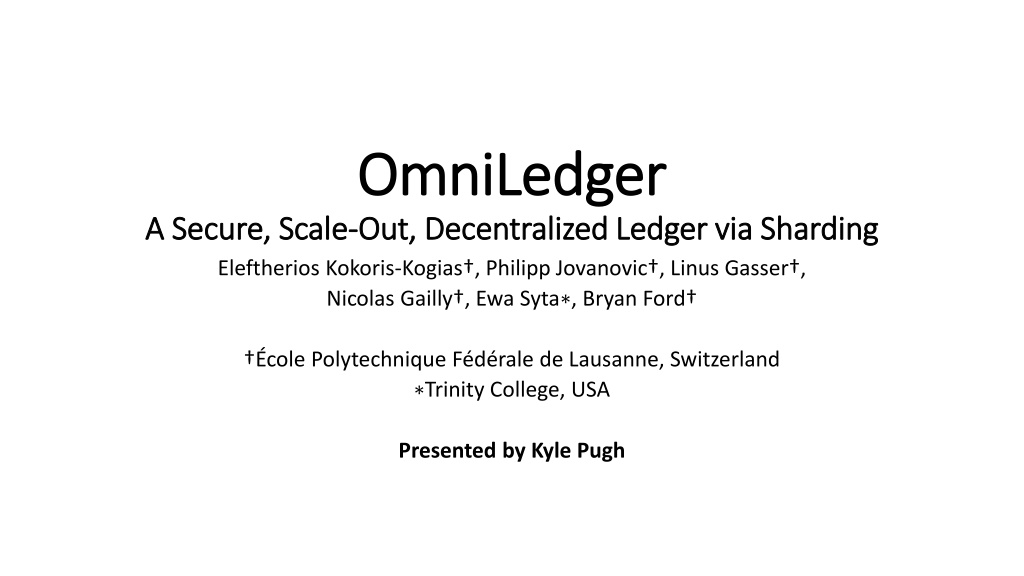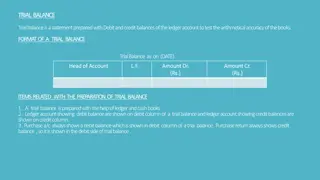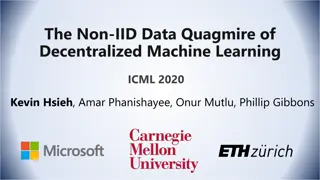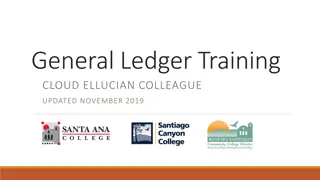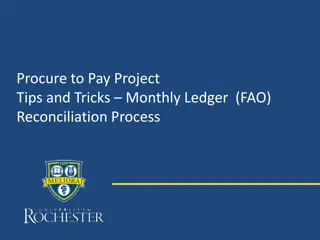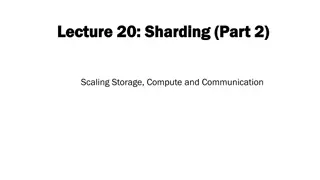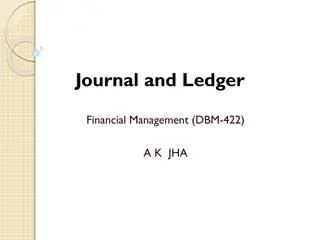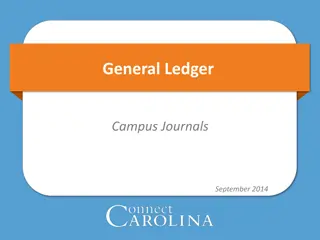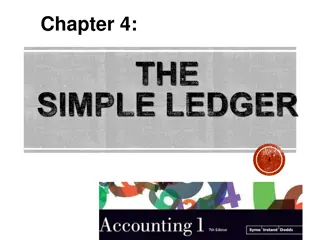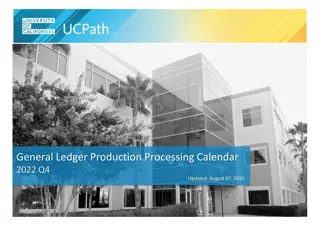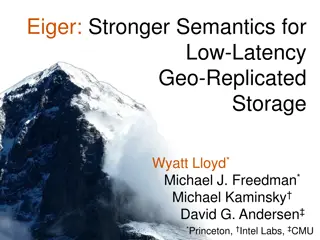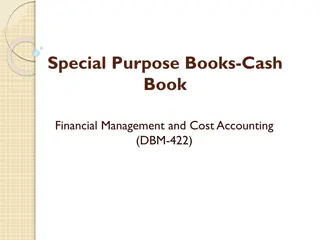OmniLedger: Decentralized Ledger with Sharding
OmniLedger is a decentralized ledger using sharding to enhance scalability without compromising security. It addresses challenges such as validator selection, cross-shard transactions, and checkpointing. The proposed solution includes ByzCoinX for consensus and Atomix for atomic commit. Goals include decentralization, shard robustness, secure transactions, scale-out, low storage overhead, and low latency.
Download Presentation

Please find below an Image/Link to download the presentation.
The content on the website is provided AS IS for your information and personal use only. It may not be sold, licensed, or shared on other websites without obtaining consent from the author.If you encounter any issues during the download, it is possible that the publisher has removed the file from their server.
You are allowed to download the files provided on this website for personal or commercial use, subject to the condition that they are used lawfully. All files are the property of their respective owners.
The content on the website is provided AS IS for your information and personal use only. It may not be sold, licensed, or shared on other websites without obtaining consent from the author.
E N D
Presentation Transcript
OmniLedger OmniLedger Out, Decentralized Ledger via Sharding Eleftherios Kokoris-Kogias , Philipp Jovanovic , Linus Gasser , Nicolas Gailly , Ewa Syta , Bryan Ford A Secure, Scale A Secure, Scale- -Out, Decentralized Ledger via Sharding cole Polytechnique F d rale de Lausanne, Switzerland Trinity College, USA Presented by Kyle Pugh
Proposed Problems Scalability of distributed ledgers (DLs) does not improve with added participants and gradually decreases with added overhead. Choose statistically representative groups of validators (shards) for sybil-resistant PoW or PoS, and ensure a negligible probability that any shard is compromised over the system lifetime but is also sufficiently large and bias-resistant. Correctly and atomically handle cross-shared transactions that affect the ledger state of two or more distinct shards. Use distributed checkpointing to help new or long offline participants catch up to the current state without having to download and verify the entire DL history. Support an optional trust-but-verify two-tier approach that allows low-value transactions to be verified quicker by a smaller, faster first-tier which is then reverified by a slower but larger second-tier to ensure long-term security. Misbehavior in the first-tier can be quickly detected and disincentivized by the second-tier.
Proposed Solutions OmniLedger uses sharding to scale-out horizontally with the number of participants without sacrificing security or permissionless decentralization. Reducing the processing load on each validator and increasing the system processing capacity proportionally to the number of participants. Use ByzCoinX, a BFT consensus protocol to increase performance and robustness against DoS attacks. Use Atomix, an atomic commit protocol to commit transactions atomically across shards. Use state blocks to minimize storage and update overhead. Optionally, use two-tier trust-but-verify processing to minimize latency of low-value transactions.
Proposed Goals Full decentralization OmniLedger does not have any single points of failure (such as trusted third parties). Shard robustness Each shard correctly and continuously processes transactions assigned to it. Secure transactions Transactions are committed atomically or eventually aborted, both within and across shards. Scale-out The expected throughput of OmniLedger increases linearly in the number of participating validators. Low storage overhead Validators do not need to store the full transaction history but only a periodically computed reference point that summarizes a shard s state. Low latency OmniLedger provides low latency for transaction confirmations.
Sharding via Bias-Resistant Distributed Randomness 1. To prevent deterministic selection that an adversary may use to cause failures, use RandHound and VRF-based leader election for trusted randomness beacon. Validators must register their sybil-resistance identity in the global identity chain during epoch e 1 to be considered as a validator in epoch e. Each validator broadcasts an identity with respective proofs on the gossip network at most before epoch e 1 ends. At the beginning of an epoch e, each validator computes a ticket ticketi,e,v= VRFski( leader confige v) where configeis the configuration containing all properly registered validators of epoch e and v is a view counter. Validators then gossip these tickets with each other for a time , after which they lock in the lowest-value valid ticket they have seen thus far and accept the corresponding node as the leader of the RandHound protocol run. If the elected node fails to start RandHound within another , validators consider the current run as failed and ignore this validator for the rest of the epoch. In this case, the validators increase the view number to v + 1 and re-run the lottery. The leader broadcasts rndetogether with its correctness proof, each of the n properly registered validators can first verify and then use rndeto compute a permutation eof 1, . . . , n and subdivide the result into m approximately equally-sized buckets, thereby determining its assignment of nodes to shards. 2. 3. 4.
Maintaining Operability During Epoch Transitions 1. 2. Gradually swap in new validators to each shard per epoch. To achieve this continued operation we can swap-out at most 1/3 of the shard s size ( n/m), however the bigger the batch is, the higher the risk gets that the number of remaining honest validators is insufficient to reach consensus and the more stress the bootstrapping of new validators causes to the network. Fix a parameter k < n/3m specifying the swap-out batch, the number of validators that are swapped out at a given time. OmniLedger works in batches of k = log(n/m). For each shard j, we derive a seed H(j rnde) to compute a permutation j,eof the shard s validators, and we specify the permutation of the batches. We also compute another seed H(0 rnde) to permute and scatter the validators who joined in epoch e and to define the order in which they will do so (again, in batches of size k). After defining the random permutations, each batch waits before starting to bootstrap in order to spread the load on the network. 3.
Cross-Shard Transactions Byzantine Shard Atomic Commit (Atomix) protocol for atomically processing transactions across shards, such that each transaction is either committed or eventually aborted.
Fault Tolerance under Byzantine Faults To achieve better fault tolerance in OmniLedger, without resorting to a PBFT-like all-to-all communication pattern, we introduce for ByzCoinX a new communication pattern that trades-off some of ByzCoin s high scalability for robustness, by changing the message propagation mechanism within the consensus group to resemble a two-level tree. During the setup of OmniLedger in an epoch, the generated randomness is not only used to assign validators to shards but also to assign them evenly to groups within a shard. The number of groups g, from which the maximum group size can be derived by taking the shard size into account, is specified in the shard policy file. At the beginning of a ByzCoinX roundtrip, the protocol leader randomly selects one of the validators in each group to be the group leader responsible for managing communication between the protocol leader and the respective group members. If a group leader does not reply before a predefined timeout, the protocol leader randomly chooses another group member to replace the failed leader. As soon as the protocol leader receives more than 2/3 of the validators acceptances, he proceeds to the next phase of the protocol. If the protocol leader fails, all validators initiate a PBFT-like view- change procedure.
Parallelizing Block Commitments Transactions that do not conflict with each other can be committed in different blocks and consequently can be safely processed in parallel. To identify conflicting transactions, we need to analyze the dependencies that are possible between transactions. Let txA and txB denote two transactions. Then, there are two cases that need to be carefully handled: (1) both txA and txB try to spend the same UTXO and (2) an UTXO created at the output of txA is spent at the input of txB (or vice versa). To address (1) and maintain consistency, only one of the two tx can be committed. To address (2), txA has to be committed to the ledger before txB, txB has to be in a block that depends (transitively) on the block containing txA. All transactions that do not exhibit these two properties can be processed safely in parallel. To capture the concurrent processing of blocks, adopt a block-based directed acyclic graph (blockDAG) as a data structure, where every block can have multiple parents. The ByzCoinX protocol leader enforces that each pending block includes only non-conflicting transactions and captures UTXO dependencies by adding the hashes of former blocks (backpointers) upon which a given block s transactions depend. To decrease the number of such hashes, we remark that UTXO dependencies are transitive, enabling us to relax the requirement that blocks have to capture all UTXO dependencies directly. Instead, a given block can simply add backpointers to a set of blocks, transitively capturing all dependencies.
Shard Ledger Pruning The issues of an ever-growing ledger and the resulting costly bootstrapping of new validators is particularly urgent for high-throughput DL systems. For example, whereas Bitcoin s blockchain grows by 144 MB per day and has a total size of about 133 GB, next-generation systems with Visa-level throughput (e.g., 4000 tx/sec and 500 B/tx) can easily produce over 150 GB per day. To reduce the storage and bootstrapping costs for validators, state blocks that are similar to stable checkpoints in PBFT summarize the entire state of a shard s ledger. To create a state block sbj,efor shard j in epoch e, the shard s validators execute the following steps: 1. At the end of e, the shard s leader stores the UTXOs in an ordered Merkle tree and puts the Merkle tree s root hash in the header of sbj,e. 2. The validators run consensus on the header of sbj,eand, if successful, the leader stores the approved header in the shard s ledger making sbj,ethe genesis block of epoch e + 1. 3. Finally, the body of sbj,e 1(UTXOs) can be discarded safely. Keep the regular blocks of epoch e, however, until after the end of epoch e + 1 for the purpose of creating transaction proofs.
Shard Ledger Pruning (continued) As OmniLedger s state is split across multiple shards and as we store only the state blocks headers in a shard s ledger, a client cannot prove the existence of a past transaction to another party by presenting an inclusion proof to the block where the transaction was committed. The responsibility of storing transactions proofs-of-existence falls to the clients of OmniLedger. During epoch e + 1 clients can generate proofs-of- existence for transactions validated in epoch e using the normal block of epoch e and the state block. Such a proof for a given transaction tx contains the Merkle tree inclusion proof to the regular block B that committed tx in epoch e and a sequence of block headers from the state block sbj,eat the end of the epoch to block B. To reduce the size of these proofs, state blocks can include several multi-hop backpointers to headers of intermediate (regular) blocks.
Optional Trust-but-Verify Validation The design of OmniLedger favors security over scalability, pessimistically assume an adversary who controls 25% of the validators and, accordingly, choose large shards at the cost of higher latency but guarantee the finality of transactions. This assumption, however, might not appropriately reflect the priorities of clients with frequent, latency-sensitive but low-value transactions and who would like to have transactions processed as quickly as possible.
Conclusions There are many instances where the authors make an assumption and never prove or qualify that it is true or even possible (I think more than 20). There is no comparison of the usage of cross-shard transactions, which will inevitably increase in likelihood as the system grows and enters each additional epoch. Yet, the paper claims that it can handle this at scale. Since these are atomic operations, this would seem to cause a bottleneck which byzantine leaders could exploit to deny transactions, increasing the bottleneck. The pruning of the ledger allows for less traffic but requires that the client perform more computations in order to confirm transactions from previous epochs. Does this allow a client to manipulate whether these transactions are correctly verified if they are byzantine in interacting with a third party? There also seems to be a trade-off of obtaining the DL history and the computations required to verify that it is valid. The paper is confusing because they present an incorrect strawman algorithm first, which makes it difficult to determine which parts, if any, of that algorithm is used.
